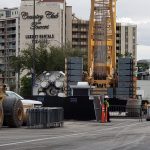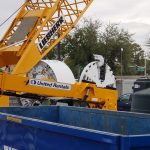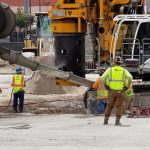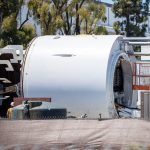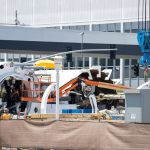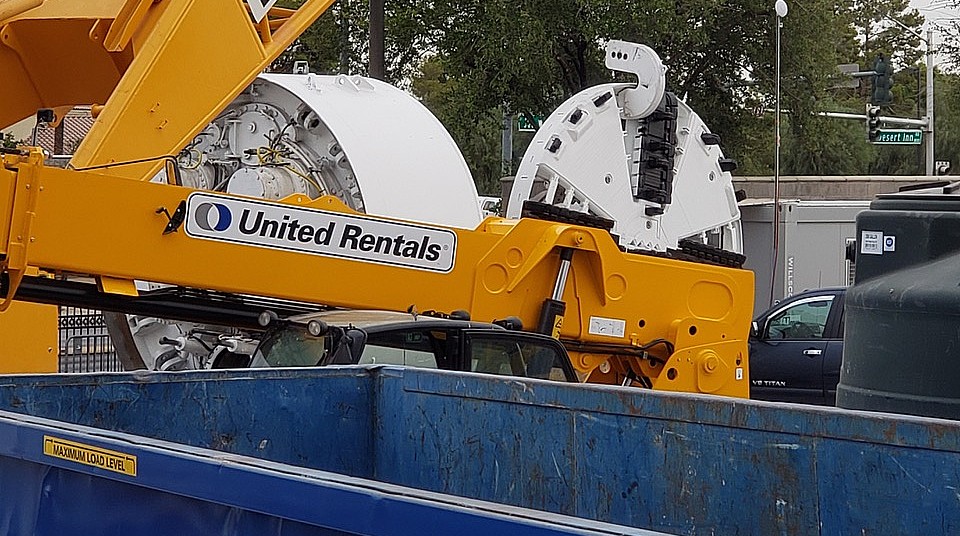

News
The Boring Company’s Las Vegas Loop tunnel project is coming to life
The Boring Company’s upcoming Loop project at the Las Vegas Convention Center appears to be coming to life, with the first images of the startup’s dig site emerging online. Images that have emerged of the startup’s activities reveal that The Boring Company has started shipping parts of a tunnel boring machine to Las Vegas, with a TBM cutter head and mixing chamber recently arriving at the location.
Initial pictures of The Boring Company’s activities were shared on Twitter last week, courtesy of @JamesInLasVegas. The photos depicted heavy machinery surrounding the tunneling startup’s dig site, including several cranes and what appeared to be a pile driver. An image of a tunnel boring machine’s cutter head was also posted.
Elon Musk's tunnel project at the Las Vegas Convention Center just went from WTF to OMFG. (via @JamesInLasVegas) @elonmusk @boringcompany pic.twitter.com/qTqgDZN8J3
— Vital Vegas (@VitalVegas) September 18, 2019
A source familiar with the Boring Company’s current activities for the Las Vegas Convention Center Loop project recently informed Teslarati that the startup’s activities have started ramping over the past few weeks. The source, who has asked to remain anonymous, added that The Boring Company has been granted a pit permit, and thus, the startup has started the construction of a secant wall for the Loop system’s passenger station located on the east end of the LVCC’s South Hall.
Similar to the initial Twitter posts that emerged of the ongoing project, the source also mentioned that parts of a tunnel boring machine started arriving Thursday night. First was what appeared to be a brand new cutter head, followed by a mixing chamber. Both these TBM parts were dropped off at a location that was visible from Desert Inn Blvd.
The Boring Company’s tunnel boring machine segments arrive at the Las Vegas site.
Interestingly, the secant wall is reportedly progressing quickly, and once this is done, excavation will soon follow. Overall, the Las Vegas Convention Center Loop appears to be progressing well, though hitting Elon Musk’s goal of completing the Loop system by the end of 2019 will likely remain a challenging task. But if the company’s digging technology is up for the challenge, the Tesla and SpaceX CEO’s timetable will likely prove feasible.
Much of the details about The Boring Company’s tunneling plans for the Las Vegas Loop system are yet to be announced. Perhaps the biggest question right now is if the startup will be deploying its next-generation TBM for the project. The Boring Company’s Hawthorne test tunnel was built using Godot, a conventional tunnel boring machine. Elon Musk has since announced that the startup is working on two new machines, a hybrid TBM named Line-Storm, which is capable of digging around twice as fast as Godot, and Prufrock, an all-electric TBM that can dig around 10-15 times faster than a conventional tunneling machine, with very little noise and zero emissions.
- The Boring Company works on a tunnel boring machine. (Credit: Teslarati)
- The Boring Company works on a tunnel boring machine.
- The Boring Company works on a tunnel boring machine.
The Boring Company works on a tunnel boring machine.
Images of what appeared to be a new TBM being assembled at the tunneling startup’s lot in the vicinity of the SpaceX headquarters in Hawthorne have been captured a few months ago. With this in mind, there seems to be a good chance that The Boring Company’s Las Vegas project could utilize one of the startup’s newer machines. Perhaps The Boring Company will play it safe and deploy Godot, which has already been tried and tested at Hawthorne, or perhaps the startup could utilize Line-Storm or Prufrock to complete the project faster.

Elon Musk
Starlink passes 9 million active customers just weeks after hitting 8 million
The milestone highlights the accelerating growth of Starlink, which has now been adding over 20,000 new users per day.

SpaceX’s Starlink satellite internet service has continued its rapid global expansion, surpassing 9 million active customers just weeks after crossing the 8 million mark.
The milestone highlights the accelerating growth of Starlink, which has now been adding over 20,000 new users per day.
9 million customers
In a post on X, SpaceX stated that Starlink now serves over 9 million active users across 155 countries, territories, and markets. The company reached 8 million customers in early November, meaning it added roughly 1 million subscribers in under seven weeks, or about 21,275 new users on average per day.
“Starlink is connecting more than 9M active customers with high-speed internet across 155 countries, territories, and many other markets,” Starlink wrote in a post on its official X account. SpaceX President Gwynne Shotwell also celebrated the milestone on X. “A huge thank you to all of our customers and congrats to the Starlink team for such an incredible product,” she wrote.
That growth rate reflects both rising demand for broadband in underserved regions and Starlink’s expanding satellite constellation, which now includes more than 9,000 low-Earth-orbit satellites designed to deliver high-speed, low-latency internet worldwide.
Starlink’s momentum
Starlink’s momentum has been building up. SpaceX reported 4.6 million Starlink customers in December 2024, followed by 7 million by August 2025, and 8 million customers in November. Independent data also suggests Starlink usage is rising sharply, with Cloudflare reporting that global web traffic from Starlink users more than doubled in 2025, as noted in an Insider report.
Starlink’s momentum is increasingly tied to SpaceX’s broader financial outlook. Elon Musk has said the satellite network is “by far” the company’s largest revenue driver, and reports suggest SpaceX may be positioning itself for an initial public offering as soon as next year, with valuations estimated as high as $1.5 trillion. Musk has also suggested in the past that Starlink could have its own IPO in the future.
News
NVIDIA Director of Robotics: Tesla FSD v14 is the first AI to pass the “Physical Turing Test”
After testing FSD v14, Fan stated that his experience with FSD felt magical at first, but it soon started to feel like a routine.

NVIDIA Director of Robotics Jim Fan has praised Tesla’s Full Self-Driving (Supervised) v14 as the first AI to pass what he described as a “Physical Turing Test.”
After testing FSD v14, Fan stated that his experience with FSD felt magical at first, but it soon started to feel like a routine. And just like smartphones today, removing it now would “actively hurt.”
Jim Fan’s hands-on FSD v14 impressions
Fan, a leading researcher in embodied AI who is currently solving Physical AI at NVIDIA and spearheading the company’s Project GR00T initiative, noted that he actually was late to the Tesla game. He was, however, one of the first to try out FSD v14.
“I was very late to own a Tesla but among the earliest to try out FSD v14. It’s perhaps the first time I experience an AI that passes the Physical Turing Test: after a long day at work, you press a button, lay back, and couldn’t tell if a neural net or a human drove you home,” Fan wrote in a post on X.
Fan added: “Despite knowing exactly how robot learning works, I still find it magical watching the steering wheel turn by itself. First it feels surreal, next it becomes routine. Then, like the smartphone, taking it away actively hurts. This is how humanity gets rewired and glued to god-like technologies.”
The Physical Turing Test
The original Turing Test was conceived by Alan Turing in 1950, and it was aimed at determining if a machine could exhibit behavior that is equivalent to or indistinguishable from a human. By focusing on text-based conversations, the original Turing Test set a high bar for natural language processing and machine learning.
This test has been passed by today’s large language models. However, the capability to converse in a humanlike manner is a completely different challenge from performing real-world problem-solving or physical interactions. Thus, Fan introduced the Physical Turing Test, which challenges AI systems to demonstrate intelligence through physical actions.
Based on Fan’s comments, Tesla has demonstrated these intelligent physical actions with FSD v14. Elon Musk agreed with the NVIDIA executive, stating in a post on X that with FSD v14, “you can sense the sentience maturing.” Musk also praised Tesla AI, calling it the best “real-world AI” today.
News
Tesla AI team burns the Christmas midnight oil by releasing FSD v14.2.2.1
The update was released just a day after FSD v14.2.2 started rolling out to customers.

Tesla is burning the midnight oil this Christmas, with the Tesla AI team quietly rolling out Full Self-Driving (Supervised) v14.2.2.1 just a day after FSD v14.2.2 started rolling out to customers.
Tesla owner shares insights on FSD v14.2.2.1
Longtime Tesla owner and FSD tester @BLKMDL3 shared some insights following several drives with FSD v14.2.2.1 in rainy Los Angeles conditions with standing water and faded lane lines. He reported zero steering hesitation or stutter, confident lane changes, and maneuvers executed with precision that evoked the performance of Tesla’s driverless Robotaxis in Austin.
Parking performance impressed, with most spots nailed perfectly, including tight, sharp turns, in single attempts without shaky steering. One minor offset happened only due to another vehicle that was parked over the line, which FSD accommodated by a few extra inches. In rain that typically erases road markings, FSD visualized lanes and turn lines better than humans, positioning itself flawlessly when entering new streets as well.
“Took it up a dark, wet, and twisty canyon road up and down the hill tonight and it went very well as to be expected. Stayed centered in the lane, kept speed well and gives a confidence inspiring steering feel where it handles these curvy roads better than the majority of human drivers,” the Tesla owner wrote in a post on X.
Tesla’s FSD v14.2.2 update
Just a day before FSD v14.2.2.1’s release, Tesla rolled out FSD v14.2.2, which was focused on smoother real-world performance, better obstacle awareness, and precise end-of-trip routing. According to the update’s release notes, FSD v14.2.2 upgrades the vision encoder neural network with higher resolution features, enhancing detection of emergency vehicles, road obstacles, and human gestures.
New Arrival Options also allowed users to select preferred drop-off styles, such as Parking Lot, Street, Driveway, Parking Garage, or Curbside, with the navigation pin automatically adjusting to the ideal spot. Other refinements include pulling over for emergency vehicles, real-time vision-based detours for blocked roads, improved gate and debris handling, and Speed Profiles for customized driving styles.
